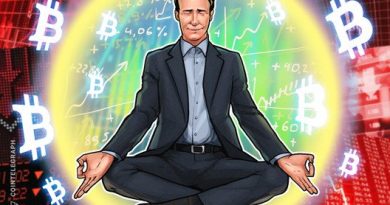DeFi market fall showcases how rising TVL doesn’t tell the full story
Could the DeFi market be a bubble as both market capitalization and indices crash?
The decentralized finance market seems to be deflating after the DeFi summer craze when tokenized versions of Bitcoin and protocols, such as Uniswap and SushiSwap, outperformed the rest of the market. Earlier in October, the two main DeFi indices, Binance’s DeFi Composite Index and TokenSet’s DeFi Pulse Index Set lost more than 60% and 50% of their value, respectively. Meanwhile, total value locked in DeFi projects has been inching closer to its all-time high of $11.2 billion since late September.
DeFi Composite Index was launched by Binance Futures in late August, and it tracks the DeFi market performance using a basket of DeFi protocol tokens listed on Binance. This index is denominated in Tether (USDT), using a weighted average of real-time prices of the basket of DeFi tokens on Binance which were selected. A rebalance of this index happens on a weekly basis where LEND was rebalanced in October due to it’s delisting.
DeFi Pulse Index launched by TokenSet selects the tokens from the top 10 DeFi protocols by TVL according to data published by Defi Pulse. This basket is rebalanced monthly as compared to the weekly rebalance done for DCI.
TVL is the value of assets locked in a particular DeFi protocol. It often serves as a metric for various DeFi sources to be the reference point for the amount of adoption and credibility of a DeFi protocol. However, it remains questionable whether TVL accurately measures the interest in the DeFi market. Sam Bankman-Fried, the chief operating officer of FTX — a crypto derivatives exchange based in Hong Kong — told Cointelegraph that this value can often be artificially inflated by subsidizing users with airdrops, similar to what Uniswap did in September. He concluded:
“TVL is a pretty meaningless metric: (a) you can pay for temporary TVL with airdrops; and (b) as more capital gets comfortable with yield farming, more farms. But yield farming doesn’t support prices.”
Gregory Klumov, the chief operating officer of Stasis — an issuer of a Euro-backed stablecoin — told Cointelegraph that the period now referred to as “the DeFi summer craze” mainly benefited the tokenized Bitcoin, adding:
“Most of the BTC protocols being utilized for farming to get additional exposure to DeFi projects without losing exposure to BTC, which seems the most logical risk-taking activity for Bitcoin investors. The TVL increase can’t be the real indicator of the DeFi token valuation, which was clearly ahead of the product development phase.”
With most of the prominent DeFi tokens losing value in the double digits in October, the cumulative market capitalization for all DeFi assets also shrunk by 25% on Oct. 8 alone; the major losers were SushiSwap (SUSHI), Uni Coin (UNI) and Yearn.finance (YFI), dropping 50.9%, 38.2% and 31.3%, respectively. This reduction in the value of DeFi assets has translated to the collaterals locked in DeFi platforms as well.
Although this drop in metrics throughout the DeFi market might seem alarming to most investors, according to Klumov, it could also be viewed as a healthy correction where DeFi assets will now find their true value, adding that TVL should not be the go-to metric: “Since the market is maturing, more complicated metrics have to be established to properly identify winners and losers.”
Ethereum transaction fees
Along with DeFi, Ethereum transaction fees have also become a pivotal talking point within the crypto community. Transaction fees are the average cost of sending Ether (ETH) over the network. These fees reached their all-time high of $15.2 on Sept. 2 before spiraling down to $1.47 on Oct. 12. This fee is still higher than the $0.08 figure that was charged at the beginning of the year. A similar hike was seen on the Bitcoin blockchain back in December 2017 when the average transaction fee went over $50, causing the daily volumes and value of transactions to fall as well.
This spike in Ethereum traction fees resulted in miners making record transaction fee revenues for two months straight over Bitcoin, which held the top spot until now. The rise in fees seems to have deterred investors in the DeFi space, as it has raised the average transaction price for each transaction. Meanwhile, Bankman-Fried pointed to the negative impacts that this increment has on DeFi transactions in Ethereum: “Volumes would probably be significantly higher if Ethereum had lower fees and higher throughput. That’s what makes me really excited about scaling solutions.”
Klumov outlined how the DeFi community, at large, has benefited from higher fees, while also lauding the Ethereum blockchain for coping well: “It raised the minimum ticket per transaction, which can compensate for the higher gas fees. That’s why other blockchains followed with their DeFi offerings, but most haven’t managed to generate enough traction.” He further added: “This is primarily because of the convenience and security Ethereum offers at the settlement level.”
The DeFi craze, combined with the high transaction fees, has caused the hash rate for the Ethereum network to hit its all-time high of more than 250 terahashes per second on Oct. 6, marking an 80% increase since January. The hash rate refers to the computing power of the network, which acts as an indicator of the health and security of a blockchain. A high hash rate improves the rate of transactions and, in turn, the revenues made by miners on these transactions, resulting in Ether being three times more rewarding to mine compared to Bitcoin (BTC).
Is the DeFi crash similar to 2008?
Back in 2008, the traditional financial markets were rocked as a result of the complex nature of products such as collateralized debt obligations and mortgage-backed securities, which confused and misled investors into opting for schemes they knew very little about. It resulted in the markets crashing, sparking a global recession and eventually costing the American economy alone $12.8 trillion.
The complexities in DeFi are often of a similar nature where both the investors and the experts do not entirely understand how the DeFi markets function. According to what Richard Red, research and strategy lead of the Decred digital currency, told Cointelegraph, “The complexity that results from the interactions of all these novel protocols means that it can be very difficult even for experts to know exactly what is happening.” He further added that “there was at one stage more Dai showing up on the Compound protocol than had been minted.”
While highlighting the similarities between the current DeFi crash and the 2008 financial crisis, it would also be important to note the differences between the two scenarios, especially from the perspective of investors, as Red said:
“Many people who participate in DeFi recognize that what they are doing is risky, but are enticed to take those risks by high rates of return on their locked assets. Another difference is the much faster speed at which the DeFi ecosystem is developing.”
In this context, DeFi contrasts sharply with the original crypto project, Bitcoin, which was motivated to build a system more resilient than the fiat economy. DeFi seems to have a different agenda wherein its degree of decentralization is being questioned due to the centralized nature of the oracles used in some of the protocols. Thus, it may result in only the key players and whales having an opportunity to evacuate once the market starts to wobble or even indulge in practices that lead to big profits for them by causing the system to tip over.
Related: DeFi Oracles, Explained




